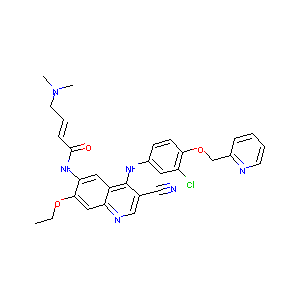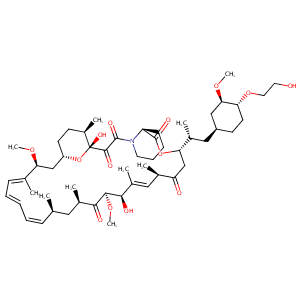| 1 |
ClinicalTrials.gov (NCT03065387) Neratinib and Everolimus, Palbociclib, or Trametinib in Treating Participants With Refractory and Advanced or Metastatic Solid Tumors With EGFR Mutation/Amplification, HER2 Mutation/Amplification, or HER3/4 Mutation or KRAS Mutation
|
| 2 |
Trusted, scientifically sound profiles of drug programs, clinical trials, safety reports, and company deals, written by scientists. Springer. 2015. Adis Insight (drug id 800021154)
|
| 3 |
Everolimus FDA Label
|
| 4 |
Drugs@FDA. U.S. Food and Drug Administration. U.S. Department of Health & Human Services. 2015
|
| 5 |
URL: http://www.guidetopharmacology.org Nucleic Acids Res. 2015 Oct 12. pii: gkv1037. The IUPHAR/BPS Guide to PHARMACOLOGY in 2016: towards curated quantitative interactions between 1300 protein targets and 6000 ligands. (Ligand id: 5889).
|
| 6 |
Coronaviruses - drug discovery and therapeutic options. Nat Rev Drug Discov. 2016 May;15(5):327-47.
|
| 7 |
A comparison of physicochemical property profiles of marketed oral drugs and orally bioavailable anti-cancer protein kinase inhibitors in clinical development. Curr Top Med Chem. 2007;7(14):1408-22.
|
| 8 |
Dual irreversible kinase inhibitors: quinazoline-based inhibitors incorporating two independent reactive centers with each targeting different cyst... Bioorg Med Chem. 2007 Jun 1;15(11):3635-48.
|
| 9 |
Identification of genotype-correlated sensitivity to selective kinase inhibitors by using high-throughput tumor cell line profiling. Proc Natl Acad Sci U S A. 2007 Dec 11;104(50):19936-41.
|
| 10 |
Pharmacodynamics, pharmacokinetics and clinical efficacy of neratinib in HER2-positive breast cancer and breast cancer with HER2 mutations. Expert Opin Drug Metab Toxicol. 2016 Aug;12(8):947-57.
|
| 11 |
A multifactorial approach to hepatobiliary transporter assessment enables improved therapeutic compound development. Toxicol Sci. 2013 Nov;136(1):216-41.
|
| 12 |
Irreversible EGFR inhibitor EKB-569 targets low-LET -radiation-triggered rel orchestration and potentiates cell death in squamous cell carcinoma. PLoS One. 2011;6(12):e29705. doi: 10.1371/journal.pone.0029705. Epub 2011 Dec 29.
|
| 13 |
Cysteine mapping in conformationally distinct kinase nucleotide binding sites: application to the design of selective covalent inhibitors. J Med Chem. 2011 Mar 10;54(5):1347-55. doi: 10.1021/jm101396q. Epub 2011 Feb 15.
|
| 14 |
Mammalian target of rapamycin, its mode of action and clinical response in metastatic clear cell carcinoma. Gan To Kagaku Ryoho. 2009 Jul;36(7):1076-9.
|
| 15 |
Closer to the Site of Action: Everolimus Concentrations in Peripheral Blood Mononuclear Cells Correlate Well With Whole Blood Concentrations. Ther Drug Monit. 2015 Oct;37(5):675-80.
|
| 16 |
The evolving experience using everolimus in clinical transplantation. Transplant Proc. 2004 Mar;36(2 Suppl):495S-499S.
|
|
|
|
|
|
|


